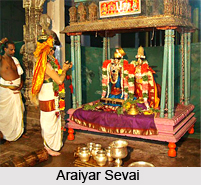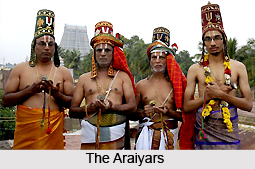 Araiyar sevai is an art form practiced in the Tamil Nadu state of India. It is a very unique offering enacted in certain Sri Vaishnava temples in Tamil Nadu such as Srirangam, Srivaikuntam, Srivilliputtur and Tirukkurugur (Alvar Tirunagari). The performance of Araiyar sevai is centered on the ritual singing and enactment of the hymns of the Divya Prabandham.
Araiyar sevai is an art form practiced in the Tamil Nadu state of India. It is a very unique offering enacted in certain Sri Vaishnava temples in Tamil Nadu such as Srirangam, Srivaikuntam, Srivilliputtur and Tirukkurugur (Alvar Tirunagari). The performance of Araiyar sevai is centered on the ritual singing and enactment of the hymns of the Divya Prabandham.
Origin of Araiyar Sevai
According to some legendary figures of Tamil Nadu, the origin of this folk art form can be traced back to the 10th-century. During that time a Vaishnavite teacher named Nathamuni compiled the Divya Prabandham. It is believed that he composed musical tunes for the hymns along with dance steps to bring out their meaning. He instituted three annual festivals, called tiruvattiyayanam for the performance of the hymns namely Pongal, Panguni uttiram and Aadi puram.
Performers of Araiyar Sevai
The Araiyars who perform this traditional art form claim themselves to be the descendents of Nathamuni. It is said that they collected the four thousand verses (pashuratnas) of the Alvars and also set them to music. This is a hereditary institution where the training is given from father to son and it is usually the eldest son who is trained specially. One needs to undergo a rigorous training for twelve to eighteen years. This is provided before a person is allowed to perform the Araiyar Sevai in the temples. The araiyars are associated with the temple as priest. They conduct certain prayers throughout the year and perform the araiyar sevai during the festivals instituted by Nathamuni.
 The kings of the ancient Tamil Nadu provided patronage to the Araiyars and they were also respected for their expertise in this dance form. They also enjoyed a special status in the temple hierarchy. But unluckily, this unique and beautiful art form is now slowly fading away and proper patronage is needed to keep this dance form alive for the future generation.
The kings of the ancient Tamil Nadu provided patronage to the Araiyars and they were also respected for their expertise in this dance form. They also enjoyed a special status in the temple hierarchy. But unluckily, this unique and beautiful art form is now slowly fading away and proper patronage is needed to keep this dance form alive for the future generation.
Performance of Araiyar Sevai
The Araiyars who provide this service (sevai) in above mentioned temples sing the devotional hymns of the `Nalayira Divya Prabandha` i.e., the four thousand hymns together with some gestures called `abhinaya`. They sing along with the beating of cymbals.
Costume of Araiyar Sevai
The performers dress themselves in traditional clothes which comprise of pancakacam (a style of wearing the veshti) and a conical hat called araiyar kullai, which bears the Vaishnavite symbols of the conch, discus and thirunamam. They also wear unique conical headgear and garlands during the performance at the temple.



















